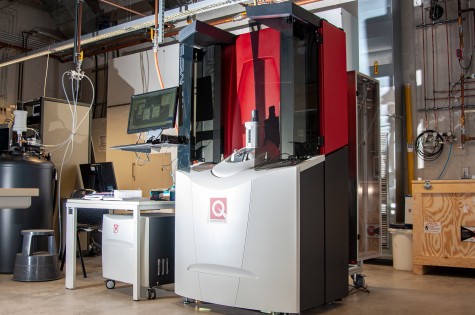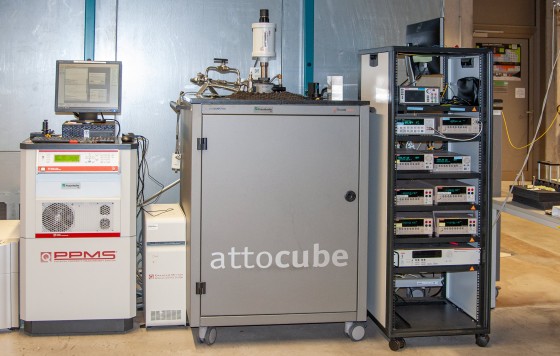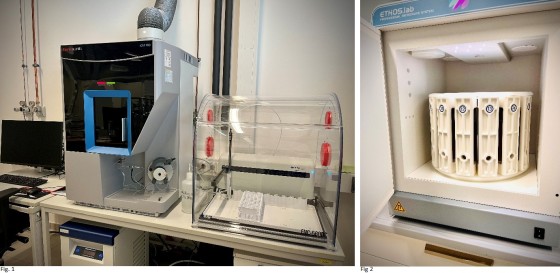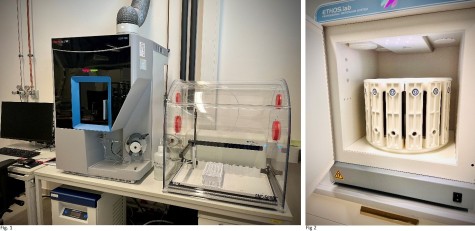Skip menu
Quick access
Functional Materials
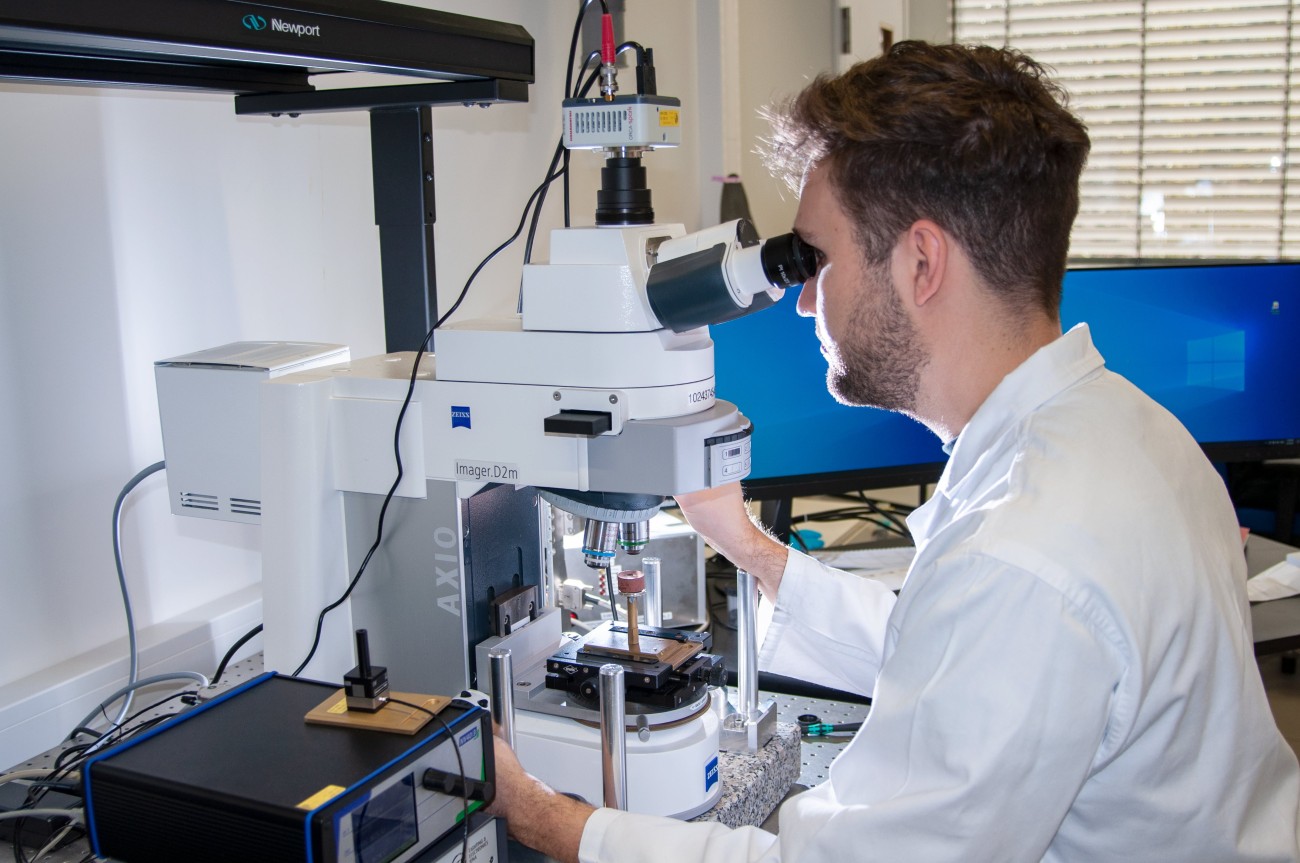
Advanced Characterization
Picture: Functional Materials
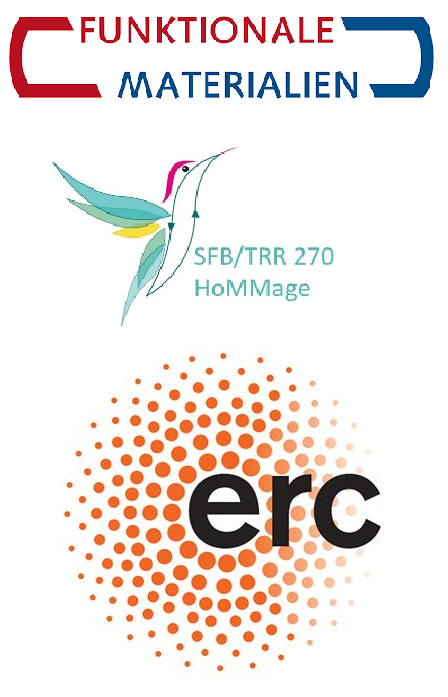
Magnetic characterisation
A vibrating-sample magnetometer (VSM) is a scientific instrument that measures magnetic properties.
Technical specifications
- Possible Measurements M(T), M(H), M(angle)
- Fields from -2 T to 2T with field resolution of 0.1 Oe
- Temperatures 77 K to 400 K (Cryo) and 300 K to 1273 K (Oven)
- Angle rotation of 360°
QD 14 Tesla PPMS – Systems
The PPMS is an automatic low-temperature and magnet system for measuring material properties such as specific heat, magnetic AC- and DC- susceptibility and electrical and thermal transport properties (such as the Hall effect, thermoelectric effectiveness and the Seebeck effect).
AC / DC MAGNETIZATION
- Temperature Range 1.9 – 350 K
- AC Frequency Range 10 Hz to 10 kHz
- AC Field Amplitude Range 2 mOe to 15 Oe
- DC Magnetization Measurements 2.5 x 10-5 emu to 5 emu
- AC Susceptibility Measurements 2 x 10-8 emu @ 10 kHz
VSM measurement parameters
- Temperature Range 1.9 – 350 K; 1000 K with the oven option
- VSM oscillation frequency 40 Hz
- VSM oscillation amplitude 2 mm peak
Torque Magnetometry (to be used with horizontal rotator)
- Temperature Range 1.9 – 350 K
- Sample Size up to 2 x 2 mm2
- Sample Mass up to 10 mg (depending on anisotropy)
Electro-Transport (to be used with horizontal rotator)
Noise
- HGA 0.5 nV/√Hz @ 1kHz (typ.)
- 1 nV/√Hz (maximum) PGA
- 5 nV/√Hz @ 1kHz (typ.),10 nV/√Hz (maximum)
Thermal Measurements
- Temperature Range 1.9 – 400 K
- Sample Size 1 – 200 mg (20 mg, typ.)
- Heat Capacity resolution 10 nJ/K @ 2 K
- Measurement Accuracy < 5%, 2–300 K < 2%, typ
- Working Pressure < 0.01 mTorr (with charcoal holder)
Thermal Transport Option
- Thermal conductivity
- Seebeck coefficient
- Electrical resistivity
- Thermoelectric figure of merit
In-house developed insert for magnetostriction measurements
- Simultaneous measurements
- Single sample characterization
- Uniform same conditions
- Precise temperature control
HMD Pressure Cell
- Maximum Applied Pressure 1.3 GPa
- Sample Space Diameter 1.7 or 2.2 mm
- Sample Space Length 7 mm max
- Cell Diameter 8.5 mm
- Temperature Range 1.9 to 400K
The magnetic interaction between the magnetic tip and the sample can be used to reconstruct the magnetic domain structure of the sample surface and provide magnetic force gradient information. Through the dual pass mode, it is possible to separate the influence of topography features and the magnetic response.
The attoAFM/MFM Ixs (attocube systems) can be operated inside of the PPMS, which allows a flexible range for in-situ experiments.
Technical specifications:
- Temperature Range 2 – 350 K
- Sample Size up to 5 x 5 x 4.5 mm3
- Out of plane magnetic field from 0 – 14 T
The magneto-optical Kerr microscope is used, with the help of the magneto-optical Kerr effect, to image magnetic domains. If linearly polarized light is radiated onto a magnetic solid, the magnetization influences the polarization state of the reflected light. After reflection, the light is generally elliptically polarized.
Technical specifications
- Field dependent measurements up to 3 kOe
- In-plane rotational and perpendicular field options
- In-plane Halbach setup On/off field 1.3 T
- Heating stage 300 K to 875 K
- Cryostat 4 K to 325 K
With a pulsed magnetometer physical properties like remanence, coercivity and maximum energy product (BH)_max can be measured. The measurement is carried out in an open circuit by variation of the external field. The advantages of the measurement technique are the short measurement time and high external fields.
Technical specifications
- Hysteresis measurements in external fields of 0 – 7
- Temperature range 0 – 180 °C
For high precision measurements of the magnetic moment of magnetized parts and for generation of homogeneous magnetic fields with easy access.
Technical specifications
- Inner diameters from 20 – 1040 mm
- Standard coils MS 20, MS 75, MS 150, MS 210
- Additional coils X-Y and X-Y-Z
Vacuum isolated calorimeter for heating response measurements in magnetic colloids
With accessory for cell culture experiments in controlled atmosphere and temperature, and a thermal image system for real time surface imaging with an IR camera.
Technical specification
- Field up to 350 G
- frequency up to 402 kHz
A device that is used to determine the deformation and flow behavior of matter.
Technical specification
- Torque 10 bis 100.000 mPa*s
- Temperature -30 ° bis 150 °C
- Frequency 10-4 bis 100 Hz
- Shear stress 10E-3 bis 105 Pa
- Shear rate 10-6 bis 105 s-1
- Viscosity 0,5*103 bis 8,5*108 Pa*s
Physical and chemical characterisation
Optical emission spectrometry with inductively coupled plasma is used to determine how much of certain elements are in a sample (samples are dissolved in a suspension). The ICP-OES technique base on the fact that atoms and ions can absorb and emit energy to move electrons between the ground state and an excited state. The characteristic emission spectra are detected by a CID-detector in axial or radial position to the plasma. ICP-OES allows trace element analysis and accurate determination of the chemical composition of materials. Solid materials must first be brought into suspension. A microwave digestion system is available for the preparation of solid materials.
ICP-OES: iCAP PRO XP Duo from Thermo Scientific
Digestion: Ethos.lab from MLS-MWS Laboratory solutions
Wavelengths:
- Intelligent Full range (iFR): 167.021 till 852.145 nm
- enhanced Ultra Violet range (eUV): 167.021 till 240.063 nm
Plasma view: radial or axial
Elemental range: Starting from Li, excluding mainly gases (N2, O2…)
Thermoanalytical technique for reaction enthalpies for determining phase transitions and heat capacities in temperature ranges from -120°C up to 1500°C.
- Two furnace options for different temperature ranges.
The 4 point measurement method is a method to determine the sheet resistance, i.e. the electrical resistance of a surface or thin layer.
Energy-dispersive X-ray spectroscopy (EDX) is an analytical technique used for the elemental analysis or chemical characterization of a sample. It relies on an interaction of some source of X-ray excitation and a sample. Its characterization capabilities are due in large part to the fundamental principle that each element has a unique atomic structure allowing a unique set of peaks on its electromagnetic emission spectrum (which is the main principle of spectroscopy). The peak positions are predicted by the Moseley's law with accuracy much better than experimental resolution of a typical EDX instrument.
Technical specification
- Tungsten Cathode 0,2 – 30 KeV
- BSE YAG – Detector
- EDX 30 mm2 SD – Detector
Device for measuring the adiabatic temperature change.
Technical specification
- Field 0 – 1,9 T
- Temperature range 77 K – 450 K
Contact
Prof. Dr. Oliver Gutfleisch

oliver.gutfleisch@tu-...
work +49 6151 16-22150
fax +49 6151 16-22145
Work
L2|07 111
Peter-Grünberg-Str. 16
64287
Darmstadt
We would like to customise the information and usability of this website to your preferences and needs.
To this end, we use so-called cookies. Please choose which cookies you would like to enable when visiting our webpages.
Some of these cookies are required to load and correctly display this website on your device.
These are strictly necessary or essential cookies and cannot be deselected.
The preferences cookie saves your language setting, while the statistics cookie regulates
how the open-source statistical software “Matomo” analyses your visits to and activities on our website.
For more information about cookies we use, please refer to our
privacy policy.


